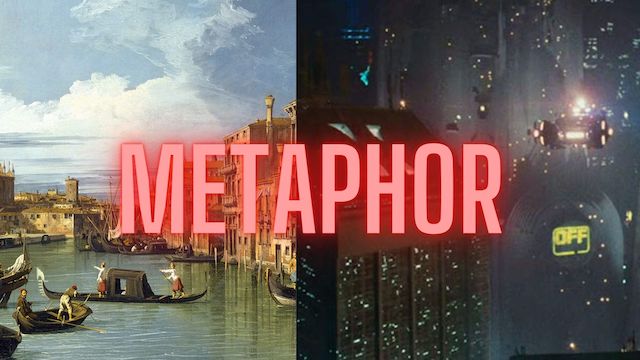Metaphors in Mystery

What is a Metaphor?
StudioBinder defines metaphor for writers.
A metaphor is a figure of speech in which a word or phrase denoting one kind of object or idea is used in place of another to suggest a likeness or an analogy between them.
Simply put, a metaphor is a comparison between two unlike things which implies they are alike.
Metaphors add color to your story with an economy of words.
One of my favorite metaphors is in Adrian McKinty’s Falling Glass as he describes the protagonist’s first view of Hong Kong: …a mashup of Canaletto and Blade Runner. No long description of harbors, boats, skyscrapers, etc. A metaphor to instantly cast images in the reader’s mind. In this case, McKinty uses an 18th Century painter and a futuristic film to give the reader a mental impression. Then the story continues uninterrupted by narrative description.
Why Use Metaphors?
Metaphors are shorthand for connecting with your reader. And they do it visually. They are little nuggets of meaning that spark a reaction in your reader. The best way to understand how you can use a metaphor is to see it in practice.
Explain abstract concepts in concrete terms
Your sleuth wants to get on with the investigation, not spend much time philosophizing. Metaphors condense a concept.
“Memories are bullets. Some whiz by and only spook you. Others tear you open and leave you in pieces.” ―Kill the Dead, Richard Kadrey
“If you can look into the seeds of time, and say which grain will grow and which will not, speak then to me.” —Macbeth, William Shakespeare
Create a sense of familiarity
In a few words, a metaphor gives the reader instant recognition of a familiar situation.
“Mr. Neck storms into class, a bull chasing thirty-three red flags.” —Speak, Laurie Anderson
Give readers a picture in their mind
Because a metaphor condenses down to imagery, the reader “sees” it in their mind.
“He could hear Beatty’s voice. ‘Sit down, Montag. Watch. Delicately, like the petals of a flower. Light the first page, light the second page. Each becomes a black butterfly. Beautiful, eh? Light the third page from the second and so on, chainsmoking, chapter by chapter, all the silly things the words mean, all the false promises, all the second-hand notions and time-worn philosophies.’” —Fahrenheit 451, Ray Bradbury
Trigger emotions
Because metaphors are concise, you can give an emotional punch to your reader.
“The parents looked upon Matilda in particular as nothing more than a scab. A scab is something you have to put up with until the time comes when you can pick it off and flick it away.” —Matilda, Roald Dahl
Illustrate a character’s worldview
When your character uses a metaphor, your reader gets an instant understanding of their personality just by the image your character uses.
“Bobby Holloway says my imagination is a three-hundred-ring circus. Currently I was in ring two hundred and ninety-nine, with elephants dancing and clowns cart wheeling and tigers leaping through rings of fire. The time had come to step back, leave the main tent, go buy some popcorn and a Coke, bliss out, cool down.” —Seize the Night, Dean Koontz
“You’re television incarnate, Diana. Indifferent to suffering, insensitive to joy.” —Network
Unleash the Metaphor Mystery
We use metaphors in everyday speech. Here’s a sampling:
- Love is a battlefield.
- You’ve given me something to chew on.
- He’s just blowing off steam.
- That is music to my ears.
- Love is a fine wine.
- She’s a thorn in my side.
- You are the light in my life.
- He has the heart of a lion.
- Am I talking to a brick wall?
But, those everyday expressions come off as clichés when we’re writing. The only time you would use them is in dialogue for an unimaginative character to illustrate their pedestrian worldview.
Mystery writers who use first-person point of view often use metaphors to illustrate the protagonist’s feelings about the people they meet and the situations they confront.
To speak the language of Goethe and Schiller, you have to stick your vowels in a pencil sharpener.
A Quiet Flame. Philip Kerr
The bottom line is that metaphors make your writing more interesting. And they do that with an immediacy that surpasses similes, when you directly state that one thing is like something else.
The best way to start with metaphors is to think about how your protagonist sleuth sees the world. What images come to his or her mind? What likes or dislikes color their daily life? Then tie those images to another character or a setting in your story.
Kick up the imaginative quality of your story.
Looking for the basics of mystery writing? Check out Write A Killer Mystery.





